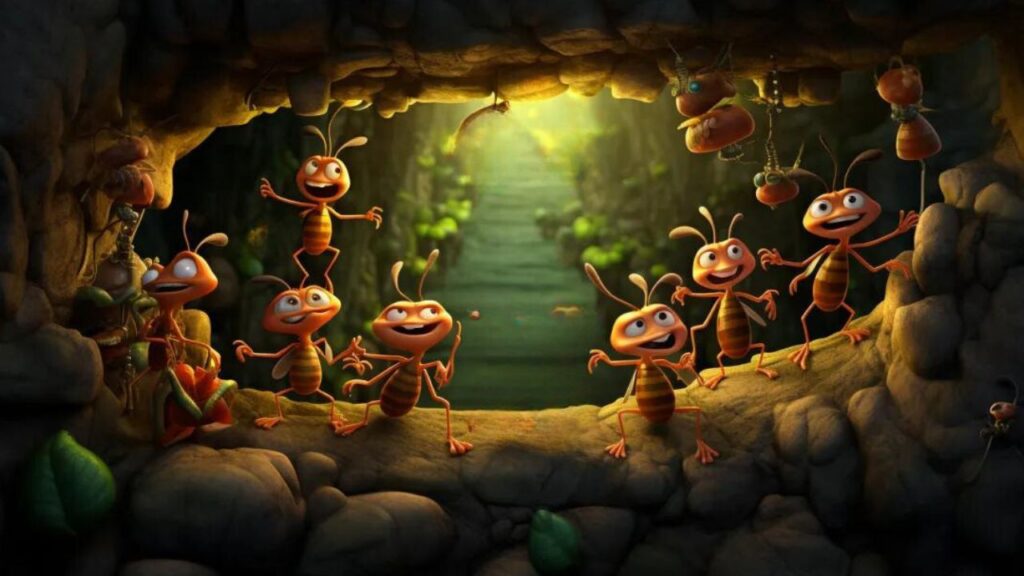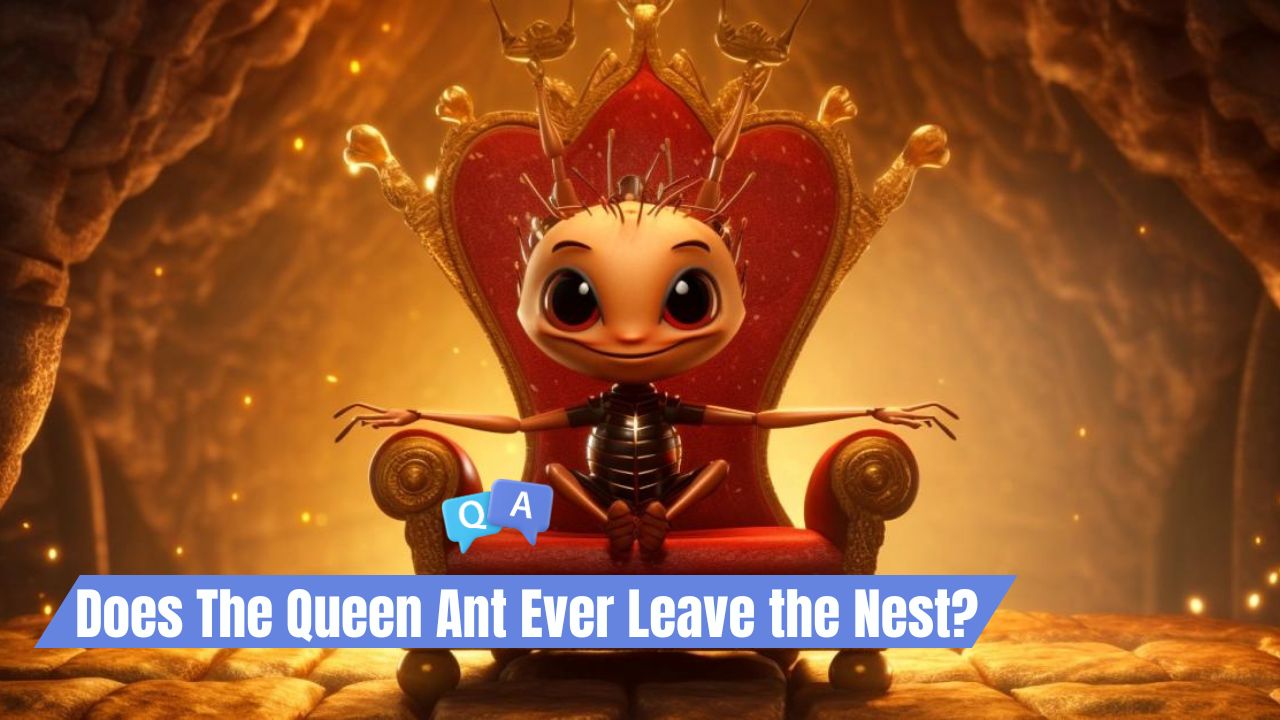TL;DR Summary
The queen ant typically remains within the nest for her entire life after her initial nuptial flight, which is the only time she leaves the nest to mate and then start a new colony. Her primary roles include egg-laying, producing pheromones for colony unity, and influencing colony dynamics through her presence. The queen’s stay within the nest is vital for her safety and the colony’s stability. Rare instances when a queen may leave the nest again include emergencies like nest disturbances or during a process known as colony fission to start a new colony. However, the queen’s absence can lead to unrest, failed succession, or even colony collapse, highlighting her critical importance to the colony’s survival.
As a passionate myrmecologist, I find myself continually fascinated by the complex societies ants build and the intricate roles each member plays within these societies. One role that garners significant interest and curiosity is that of the queen ant, often shrouded in mystery and commonly misunderstood. Many of my readers have asked, “Does the queen ant ever leave the nest?” This question is not only intriguing but also opens a portal to understanding the life strategies of these incredible insects. In this article, we will embark on a journey through the life of a queen ant, examining her critical role within the colony and exploring the circumstances that may lead her to venture outside the safety of her nest.
The Role of a Queen Ant
- Foundational Importance: The queen ant is the cornerstone of ant society. Her primary function is to lay eggs, thus ensuring the colony’s survival and growth. She is typically the mother of all the other ants in the colony, making her role vital for the genetic continuation of the community.
- Lifespan and Contribution: Compared to her offspring, the queen has a remarkably long lifespan, living for several years or even decades in some species. This longevity allows her to produce thousands, if not millions, of offspring, securing the colony’s lineage over time.
- Pheromone Powerhouse: Beyond reproduction, the queen ant exudes pheromones that regulate the behavior and development of her colony. These chemical signals maintain social organization and cohesiveness, which are essential for the colony’s success.
Understanding Ant Colonies
- Complex Social Systems: Ant colonies are marvels of natural engineering and social organization. Each ant has a specific role, from workers and soldiers to the queen herself. The colony operates as a single unit, often described as a superorganism, with each member contributing to the collective well-being.
- Division of Labor: Worker ants, which are sterile females, perform the tasks of foraging, caring for the young, and defending the nest. Male ants, often called drones, have the sole purpose of mating with the queen during her nuptial flight.
- Colony Life Cycle: Ant colonies go through various stages, from founding to growth, and eventually, decline. The queen’s presence and health are critical throughout these stages, influencing the colony’s ability to adapt and survive.
Purpose of This Exploration
- Addressing Common Myths: There are many misconceptions about the life of a queen ant, particularly regarding her mobility and the necessity of her leaving the nest. Through this exploration, we aim to dispel myths and bring to light the true nature of a queen ant’s existence.
- Educational Insight: By providing a detailed look into the queen ant’s role, we not only satisfy curiosity but also offer educational insight into the workings of ant colonies. This knowledge fosters a greater appreciation for these insects and their impact on ecosystems.
- Scientific Inquiry: As we delve into the specifics of the queen ant’s behavior, we contribute to the broader scientific understanding of myrmecology. Each piece of knowledge we uncover adds to the collective database of ant biology and ecology.
In the following sections, we will explore the lifecycle of the queen ant, her duties within the colony, instances that may compel her to leave the nest, and the profound impact her presence or absence has on her colony. Join me in uncovering the intricate details of a queen ant’s life and the pivotal question: Does the queen ant ever leave the nest?
Lifecycle of the Queen Ant

Embarking on an exploration of the queen ant’s lifecycle offers a window into the perpetual cycles of nature and the enduring success of ant societies. The lifecycle of a queen ant is a remarkable journey, marked by a series of pivotal events that shape the destiny of her colony.
Nuptial Flight: The Beginning
- The Maiden Voyage: The nuptial flight is the inaugural and often the only flight a queen ant will ever undertake. It is a seminal event in her life where, upon reaching maturity, she takes to the skies with wings that she will later shed. This flight is not a solitary endeavor; it is coordinated with many other ants of various colonies of the same species, ensuring genetic diversity.
- Mating in Mid-Air: During this flight, the queen mates with multiple males — the drones — in a spectacular mid-air dance. The drones, having fulfilled their life’s purpose, soon perish after the act, while the queen stores the sperm in a special organ called the spermatheca, which will last her entire life.
- The Descent and De-alation: After the nuptial flight, the now-mated queen ant will land and undergo a process known as de-alation, where she purposefully removes her wings. The loss of her wings signifies the end of her flying days and the beginning of her new role as the foundress of a new colony.
After Mating: Establishing a Colony
- Finding a Suitable Site: Post-flight, the queen must quickly find a suitable location to start her colony. This site must offer protection and the right conditions for her to lay her first clutch of eggs. The survival rate at this stage is low, as the queen is vulnerable to predators and environmental challenges.
- Laying the Foundation: Once a site is secured, the queen’s first batch of eggs will hatch into worker ants. These initial offspring are crucial, as they will assume the duties of foraging and expanding the nest, allowing the queen to focus solely on laying more eggs.
- The Growth Phase: As the first workers take on the tasks necessary for the colony’s survival, the queen’s role becomes increasingly centralized to reproduction. The colony enters a phase of growth as the number of workers increases, which, in turn, allows for greater expansion and resource acquisition.
Longevity and Survival
- Remarkable Lifespan: Queen ants are among the longest-lived insects, with lifespans ranging from a few years to several decades depending on the species. This extended lifespan is crucial for the stability and longevity of the colony.
- Genetic Wealth: Throughout her life, the queen uses the sperm stored from her nuptial flight to fertilize eggs. Her genetic contribution endures throughout her life and even beyond, as her offspring continue to propagate her genetic material.
- Ensuring Continuity: The queen’s survival is synonymous with the colony’s endurance. Worker ants go to extraordinary lengths to protect their queen, recognizing that her health and wellbeing directly correlate with the future of their entire colony.
The lifecycle of a queen ant is a testament to the resilience and complexity of these social insects. From her daring nuptial flight to the silent dedication to her offspring, the queen plays a relentless role in the perpetuation of her species. It’s a life marked by self-sacrifice, strategic genetic investment, and an unwavering commitment to her colony’s prosperity. As we continue our journey through the world of ants, it becomes clear that the existence of the queen is not just about her individual survival, but the survival of a collective legacy she carries within her.
Duties of a Queen Ant

In the riveting hierarchy of ant colonies, the queen ant is often perceived as the supreme ruler. Her duties, however, are not centered around command but are deeply rooted in sustaining the colony. Let’s delve into the core responsibilities that define the queen’s existence within this well-organized insect society.
Egg-Laying: The Primary Function
- The Heartbeat of the Colony: Egg-laying is the queen’s primary and continuous duty. Her ability to produce offspring dictates the colony’s size and health. As a prolific egg-layer, she ensures a steady stream of workers, soldiers, and future reproductive ants that will carry on the colony’s legacy.
- A Balanced Brood: The queen’s egg-laying is not random; it’s a nuanced balance of producing the right mix of worker ants for maintenance and care, soldiers for defense, and new reproductives for the perpetuation of the species.
- Adaptive Reproduction: The queen can adjust her egg-laying rate based on the colony’s needs, which can be influenced by factors such as food availability, season, and the overall health of the colony. This adaptability is crucial for the colony’s resilience in the face of fluctuating environmental conditions.
Pheromone Production for Colony Unity
- Chemical Communication: The queen synthesizes and releases pheromones that serve as chemical signals to maintain social order and unity within the colony. These pheromones are potent and multifunctional, carrying messages that can alter behavior, suppress or stimulate reproduction, and even direct the colony’s daily activities.
- Bonding the Colony: Pheromones produced by the queen help to create a unique colony scent that bonds the ants together. This scent is shared among all members through mutual grooming and food exchange, fostering a strong communal identity.
- Regulating Growth: The queen’s pheromones also play a crucial role in regulating the development of the colony. For instance, they can inhibit the development of other potential queens, ensuring that no other individual challenges her role until it is time for the colony to expand or replace her.
Decision-Making and Control
- Influence Over the Colony: While the queen is not issuing direct commands to her subjects, her influence is embedded in the genetic makeup and the pheromone signals she disperses. These signals are decoded by the worker ants, who then execute tasks in response to her indirect ‘decisions’.
- Resource Allocation: The queen’s health and egg-laying capacity influence how resources are allocated within the colony. Workers prioritize her nourishment and care, understanding that the colony’s future hinges on her well-being.
- Succession Planning: In some ant species, the queen’s influence extends to planning for her succession. When her productivity declines, her pheromone output changes, which can trigger the colony to raise new queens and males for future nuptial flights.
The duties of a queen ant are intrinsic to her biological makeup and are executed with an inherent precision that underpins the colony’s existence. From laying eggs to unifying her colony with pheromones, and influencing its genetic destiny, the queen’s role is both complex and critical. Her life is a perpetual commitment to the survival and expansion of her colony, an embodiment of nature’s profound instinct for continuity.
Nest Dynamics and the Queen’s Mobility

The architecture of an ant nest is a marvel of natural engineering, evolved to support the specific needs of the colony’s members, especially the queen. Let’s explore the intricacies of nest dynamics and how they cater to the queen’s mobility and overall well-being.
Nest Structure and Queen Chambers
- Architectural Mastery: Ant nests can range from simple underground burrows to intricate multi-chambered structures, depending on the species. These constructions are designed to facilitate efficient colony operations and provide optimal living conditions.
- The Royal Suite: The queen’s chamber is a specialized area within the nest, often located deep within the safest and most protected part of the structure. This secluded room is not just a residence but a hub from which the queen governs her biological duties.
- Climate Control: The queen’s chamber maintains a stable microclimate suitable for egg laying and brood development. Temperature, humidity, and even carbon dioxide levels are regulated by the workers to create an ideal environment for the queen and her offspring.
Workers’ Role in Queen Care
- Dedicated Attendants: Worker ants are not only architects but also the queen’s caregivers. They attend to her every need, from feeding her and disposing of her waste to grooming and protecting her from threats.
- Nursemaids to the Brood: Workers also act as nursemaids to the queen’s eggs and larvae. They meticulously manage the brood, moving eggs and larvae to different chambers within the nest to ensure optimal growth conditions.
- Defenders of the Throne: The security of the queen is paramount. Worker ants will defend the queen with their lives during invasions by predators or rival colonies, often evacuating her to a safe location if the nest is breached.
Queen’s Movement Inside the Nest
- Limited Locomotion: The queen ant’s movement within the nest is generally limited to the queen’s chamber and adjacent areas. This restricted mobility is a strategic adaptation that minimizes her exposure to threats and conserves her energy for egg production.
- A Guided Tour: On the rare occasions when the queen does move, she is often escorted by a retinue of worker ants. These escorts ensure her safety and guide her through the nest’s labyrinthine corridors.
- The Significance of Movement: Any movement by the queen within the nest is a significant event and is often related to the health and expansion of the colony. Whether she is relocating to a new chamber to avoid pathogens or to accommodate a growing brood, her movements are carefully choreographed by the worker ants.
The dynamics of the nest and the queen’s mobility are a testament to the ant colony’s complex social structure. Every aspect of the nest’s design and the behavior of the worker ants is geared towards supporting the queen’s essential role. The queen, though seemingly stationary, is the beating heart of the nest, with her presence and health resonating through every chamber and tunnel. She is central not just in location but in purpose, her limited but profound movements within the nest signaling key moments in the life of the colony.
Instances When a Queen Might Leave the Nest

The life of a queen ant is predominantly spent within the confines of the nest. However, there are specific instances in the lifecycle of a colony when a queen may leave her established domain. Each scenario is significant and can have profound implications for the future of the colony.
Nuptial Flight: A One-Time Journey
- The Inaugural Flight: The nuptial flight represents the only time a virgin queen ant, known as a princess, ventures out from her birth colony. This maiden flight is a pivotal moment, marking the transition from princess to queen, and the beginning of a new colony.
- Synchronized Emergence: This event is typically synchronized with other colonies of the same species, creating a mass exodus of potential queens and males. The synchronization increases the chances of successful mating and reduces the risk of inbreeding.
- The Last Time Aloft: After mating, the queen ant lands, sheds her wings, and never takes flight again. She invests all her subsequent energy into founding her colony and laying eggs.
In Case of Nest Disturbance or Threat
- Emergency Evacuation: A queen may be forced to leave her nest if it is severely disturbed or destroyed. Natural events like flooding, or interference by animals or humans, can necessitate an emergency move.
- Worker-Led Exodus: In such cases, worker ants will quickly rally to protect and transport the queen to a new location. This is a perilous time for the colony, as the queen’s vulnerability is at its highest.
- Securing the Lineage: The primary objective during such disturbances is to secure the queen’s safety and find a suitable new site to reestablish the nest. The survival of the queen ensures the continuation of the colony’s lineage.
Colony Fission: When a Queen Starts Anew
- Planned Division: Some ant species practice a form of colony reproduction known as fission, where a queen and a contingent of workers leave the established colony to form a new one. This is a strategic move, allowing the ant species to spread and colonize new areas.
- Secondary Nests: In certain species, queens may establish multiple nests that are part of the same colony. These polydomous colonies have interconnected nests with workers moving freely between them.
- A Calculated Risk: Leaving the safety of the nest to start a new colony is a calculated risk, balanced by the potential rewards of spreading the colony’s genetic material and securing new resources.
The departure of a queen ant from her nest is a rare and significant event, typically driven by the biological imperative to reproduce, survive, and ensure the continuity of the colony. Whether it’s the nuptial flight, a response to an emergency, or a strategic colony fission, each instance when a queen ant leaves her nest marks a momentous occasion in the life cycle of ant societies. These events are orchestrated by the collective intelligence and survival instincts of the ants, showcasing the remarkable adaptability and resilience of these social insects.
Comparison with Other Ant Species

Ants exhibit a dazzling variety of lifestyles and social structures. This diversity is especially evident in the roles and mobility of queen ants across different species. By comparing the queen dynamics of leafcutter ants, army ants, and weaver ants, we gain a richer understanding of the adaptability and evolutionary ingenuity of these insects.
Leafcutter Ants: A Different Strategy
- Agricultural Pioneers: Leafcutter ants are renowned for their sophisticated form of agriculture, cultivating fungus gardens within their nests. The queen plays a critical role in initiating these gardens from a small piece of fungus carried from her birth colony.
- One-Time Colonizers: Similar to many other ant species, a leafcutter ant queen will leave her original nest only once to mate and found a new colony. After her nuptial flight, she burrows into the ground to start her fungus garden and lay the first batch of eggs.
- Generational Continuity: Leafcutter ant queens can live for over a decade, and during this time, they rarely, if ever, leave the nest again. Their primary function becomes laying eggs and perpetuating the fungus cultivation through their offspring.
Army Ants: Nomadic Queens
- Migratory Lifestyle: Army ant queens break the mold with their nomadic lifestyle. Unlike the stationary queens of other species, army ant queens are constantly on the move with their colonies.
- Swarming Colonies: These ants don’t build permanent nests. Instead, the queen moves with a swarm of workers in a bivouac – a temporary nest made of the ants’ own bodies. As the colony raids for food, the queen is at the center of this living nest, laying thousands of eggs in a cycle synchronized with the colony’s migratory phase.
- Adaptive Reproduction: The nomadic queen’s reproductive cycle is highly adapted to this mobile lifestyle. She can lay large numbers of eggs in a short time to ensure the colony’s rapid growth and survival as they traverse through different territories.
Weaver Ants: High Nest Mobility
- Arboreal Architects: Weaver ant queens reside in nests made from leaves stitched together with silk produced by their larvae. These nests are often high in the tree canopy, requiring a level of mobility from the queen.
- Multiple Nests: Unlike other ant queens, weaver ant queens may travel between multiple nests within their territory. This mobility is vital for the maintenance of their expansive arboreal domains and the dispersion of their brood.
- Strategic Relocation: The queen’s movement is strategic and is aimed at optimizing the colony’s resources and space. As the colony grows and the spatial dynamics change, the queen may relocate to new nests to better distribute her offspring.
The lifestyles of leafcutter, army, and weaver ant queens illustrate the remarkable evolutionary adaptations of ant species. Each queen’s role and degree of mobility are fine-tuned to her environment and the survival strategies of her colony. From the sedentary queen of the leafcutters to the perpetually mobile queen of the army ants, and the strategically relocating weaver ant queen, these variations underscore the complexity and ingenuity of ant societies. It’s a testament to the incredible diversity of life strategies that have evolved among these fascinating insects, each ensuring the survival and proliferation of their species in unique ways.
Impact on the Colony When the Queen Leaves

The queen ant is the linchpin of the colony, her presence or absence resonates throughout the community. When a queen leaves or is lost, the impact on the colony is immediate and, at times, irreversible. Understanding this impact reveals much about the delicate balance of ant society and the critical role of the queen.
The Colony’s Reaction to Queen’s Absence
- Immediate Unrest: The absence of a queen triggers a state of unrest in the colony. Worker ants may become agitated or disoriented without the queen’s pheromonal cues that guide their daily activities and social structure.
- Search and Rescue Efforts: Initially, workers may engage in frantic search activities to locate their missing monarch. This period is marked by a noticeable decline in routine tasks such as foraging and brood care.
- Pheromonal Shifts: Over time, the lack of the queen’s pheromones causes a shift in the colony’s behavior. Workers may begin to lay unfertilized eggs that can only develop into male ants, further destabilizing the colony’s future.
Succession: Raising a New Queen
- Emergency Measures: In some species, if a queen is lost, the colony can take emergency measures to raise a new queen. This process involves selecting a larva and feeding it a special diet to develop into a queen.
- Royal Pheromones: The presence of royal pheromones is crucial in suppressing the development of new queens. Without these pheromones, the colony can initiate the development of replacement queens from the existing brood.
- Critical Timing: The success of raising a new queen is time-sensitive and depends on the availability of suitable larvae and resources. If the colony is too weak or the brood is not at the correct developmental stage, succession may fail.
Colony Collapse: The Ultimate Risk
- Demographic Downfall: Without a queen, a colony cannot sustain its population. Worker ants, being sterile, cannot produce female offspring to take over the roles necessary for the colony’s maintenance and growth.
- The End of a Dynasty: Eventually, the absence of a queen leads to the collapse of the colony. As the existing workers age and die, there are no new ants to replace them, leading to the inevitable demise of the colony.
- Ecological Impact: The collapse of a colony affects not just the ants but the surrounding ecosystem. Ants play vital roles in soil aeration, seed dispersion, and pest control. The loss of a colony can therefore have ripple effects on the local environment.
The departure or death of a queen ant can set in motion a series of events that highlight the intricate dependence of the colony on their queen. While some ant societies have mechanisms to recover from such a loss, for many, the queen’s absence marks the beginning of the end. Her role is so integral that without her, the complex social order and efficient functioning of the colony quickly unravel. This stark reality underscores the queen’s pivotal role and the delicate equilibrium within ant colonies that she helps to maintain.
Conclusion

Our journey through the life and influence of a queen ant within her colony brings us to a close, full of admiration for these remarkable insects and the sophisticated societies they create. Let’s recap the insights gleaned and the significance of the queen’s role in the grand tapestry of ant colony dynamics.
Recap of the Queen Ant’s Role
- The Foundational Pillar: The queen ant emerges as the foundational pillar of the colony, her primary role being to lay eggs and secure the future generation of ants. Her very existence enables the continuity and expansion of her colony.
- The Chemical Sovereign: Beyond reproduction, the queen is a chemical sovereign, her pheromones weaving the social fabric of the colony, guiding and regulating the lives of her subjects, ensuring cohesion and operational efficiency.
- A Life of Service: Her life is one of service to the colony, from the perilous maiden flight to establish a new home, to the daily task of egg-laying, and the subtle governance through chemical signals.
Significance of the Queen’s Stay in the Nest
- A Safe Monarchy: The queen’s stay within the nest is not a sign of passivity but a strategic necessity. The security and stability of her environment allow her to focus on her critical duties without the risks that the outside world presents.
- The Heart of the Hive: The queen’s presence in the nest serves as the beating heart of the colony, a constant source of renewal and direction. Her chamber, deep within the nest, is more than a royal residence; it is the central command of a complex biological enterprise.
- An Indispensable Presence: It is clear that the queen’s place is within the nest. Here, she is most valuable and most protected, surrounded by her loyal workers who are finely attuned to her needs and the requirements of their collective home.
Final Thoughts on Ant Colony Dynamics
- A Microcosm of Society: The ant colony is a microcosm of society, each member playing a part, with the queen as a central figure. The dynamics we observe in the colony—from cooperation and role specialization to adaptation and resilience—reflect the intricate balance of life itself.
- Reflections of Nature’s Wisdom: In the queen’s journey and the colony’s response to her presence or absence, we see reflections of nature’s wisdom, the delicate balance between individual purpose and collective survival.
- The Legacy Continues: Even as we conclude, the life of the queen ant and her colony continues in a perpetual cycle of growth, adaptation, and renewal. Theirs is a legacy written in the soil, a testament to the enduring success of their kind.
As we step back from the world of ants, we carry with us a greater understanding and respect for these tiny yet mighty creatures. Their complex societies, driven by the unseen hand of the queen, are a reminder of the intricate connections that sustain life on our planet. The queen ant, often unseen, is ever-present, a symbol of life’s tenacious grasp and the unyielding drive of nature’s will to flourish.

